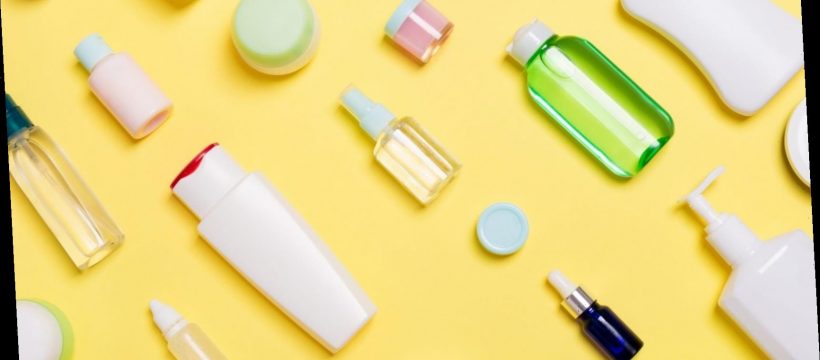A consultant dermatologist runs through the steps for your morning and night products so you can reap all the benefits.
During lockdown, you may have found yourself delegating more time towards a skincare routine. It’s one of the few things that can provide a bit of structure to your day. In fact, members of the Stylist team have noted that it’s also a great way to practice self-care.
It’s also satisfying when you notice that a great skincare product is actually working. “To see long-term benefits for your skin it is important to stick to a skincare routine,” says Dr Anjali Mahto, consultant dermatologist at Skin55 and author of The Skincare Bible: Your No-Nonsense Guide to Great Skin.
However, it’s important to stick with your routine to see the full benefits of your products’ ingredients. “How long it is before you see results depends on the product and its purpose,” says Dr Mahto. “For active ingredients such as vitamin A for example, it can take up to 12 weeks to see any real benefits to the skin. People often chop and change their routines too quickly and it is worth being patient to see full benefits from skincare.”
She adds: “Like everything in life and this applies to skin in the same way as exercise and nutrition, there is no magic bullet or quick fix to see results. Sustained behaviour over a long period of time is where one will reap the benefits.”
But with so many incredible ingredients out there, it can be tricky to know the best way to order your skincare products and reap all the benefits as effectively as possible.
Here, Dr Mahto runs through the products you should be using in a basic morning and nighttime skincare routine. Plus, the correct order to use and layer them…
MORNING SKINCARE ROUTINE
What products should you use in the morning?
“For a basic skincare routine, morning products should include cleanser, antioxidant serum, moisturiser and sunscreen.”
What order should you use your morning products in?
“The first step of the morning skincare routine is cleansing.This removes any actives applied overnight and creates a fresh base for other products to then be applied.Oily and blemish-prone skin types can benefit from foaming cleansers whilst those with dry, sensitive or mature skin may prefer to opt for a cream cleanser.
“After cleansing, apply a few drops of antioxidant serum, for example vitamin C.Serums should be layered under moisturisers as often it is best to go from “thinnest to thickest” to aid absorption; however, this is not a hard and fast rule as there are very few clinical studies which actually look at what order of products is best.
“Once the serum has been applied, for those with normal, sensitive or dry skin types will benefit from a moisturiser to help smooth out the surface appearance of the skin, prevent water loss from the skin surface, and improve the barrier function of the skin.
“Finally, broad-spectrum sunscreen, ideally SPF 30-50 with UVA and UVB protection should be applied to the skin; aim for half a teaspoon to the face and neck.It is better to use a separate sunscreen rather than SPF in your moisturiser as it offers greater protection from the sun.Many sunscreens come in a moisturising base and those with oily or acneic skin may wish to skip moisturiser and apply the sunscreen directly after their antioxidant serum.”
NIGHTTIME SKINCARE ROUTINE
What products should you use in the at night?
“I would recommend a micellar water, cleanser, vitamin A and moisturiser at night.”
What order should you use your night products in?
“The first part of your night time skincare routine should be to remove make-up and sunscreen and I find the easiest way to do this is with a micellar water although other options such as cleansing balms exist. The key is to ensure you are double cleansing to remove all the products applied during the day.
“After make-up has been removed then I would suggest using a facial cleanser, similar to the morning format. Oily skins may prefer a foaming cleanser where dry skin types may want to opt for a cream cleanser instead. The second cleanse will remove any dirt, sweat, bacteria or grime the skin has come into contact with during the day as well as residual skincare products.
“Once the skin is clean it means it is prepared for the next steps. Using a vitamin A or retinoid based cream at night to the face can then help with tackling the signs of premature skin ageing such as fine lines, wrinkles, and pigmentation. Retinoids will boost collagen production and improve skin cell turnover improving overall skin tone.
“Fifteen to 20 minutes after applying the vitamin A product, using a simple fragrance-free moisturiser to the skin can be of benefit. Vitamin A can irritate the skin leading to dryness, sensitivity and flaking. Using a moisturiser afterwards can help reduce these symptoms and improve tolerability.”
Main image: Getty
If you’re an avid Stylist fan, you’ll know it’s not always possible to find an issue of our magazine. Often they’re gone before you head into work (they disappear fast!), or you live in a part of the UK where you can’t get your hands on a copy. Add to this the fact that millions of us are not commuting right now, and we wanted to ensure you don’t miss out on the magazine any longer.
Which is why we’re delighted to let you know that Stylist magazine is now available in a digital format, both for Apple and Android users, allowing you to download the full magazine directly to your smartphone or tablet, wherever you may be.
Pricing for our digital magazine starts at just 99p for a single issue, or £21.99 for a full year’s subscription –that’s less than 50p a week!Simply click on the link to activate your Stylist app download from either the Apple store or Google Play and enjoy!
Source: Read Full Article
